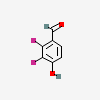2,3-Difluoro-4-hydroxybenzaldehyde
- 2,3-Difluoro-4-hydroxybenzaldehyde
- 676500-39-3
- MFCD08235194
- DTXSID20630621
- 2,3-difluoro-4-hydroxy-benzaldehyde
- Create:2007-12-05
- Modify:2025-01-04


H315 (100%): Causes skin irritation [Warning Skin corrosion/irritation]
H319 (100%): Causes serious eye irritation [Warning Serious eye damage/eye irritation]
H335 (100%): May cause respiratory irritation [Warning Specific target organ toxicity, single exposure; Respiratory tract irritation]
P261, P264, P264+P265, P271, P280, P302+P352, P304+P340, P305+P351+P338, P319, P321, P332+P317, P337+P317, P362+P364, P403+P233, P405, and P501
(The corresponding statement to each P-code can be found at the GHS Classification page.)
Aggregated GHS information provided per 8 reports by companies from 3 notifications to the ECHA C&L Inventory. Each notification may be associated with multiple companies.
Information may vary between notifications depending on impurities, additives, and other factors. The percentage value in parenthesis indicates the notified classification ratio from companies that provide hazard codes. Only hazard codes with percentage values above 10% are shown.
Skin Irrit. 2 (100%)
Eye Irrit. 2A (100%)
STOT SE 3 (100%)
Patents are available for this chemical structure:
https://patentscope.wipo.int/search/en/result.jsf?inchikey=KTGPDDPEVRJSFY-UHFFFAOYSA-N
- EPA DSSTox2,3-Difluoro-4-hydroxybenzaldehydehttps://comptox.epa.gov/dashboard/DTXSID20630621CompTox Chemicals Dashboard Chemical Listshttps://comptox.epa.gov/dashboard/chemical-lists/
- European Chemicals Agency (ECHA)LICENSEUse of the information, documents and data from the ECHA website is subject to the terms and conditions of this Legal Notice, and subject to other binding limitations provided for under applicable law, the information, documents and data made available on the ECHA website may be reproduced, distributed and/or used, totally or in part, for non-commercial purposes provided that ECHA is acknowledged as the source: "Source: European Chemicals Agency, http://echa.europa.eu/". Such acknowledgement must be included in each copy of the material. ECHA permits and encourages organisations and individuals to create links to the ECHA website under the following cumulative conditions: Links can only be made to webpages that provide a link to the Legal Notice page.https://echa.europa.eu/web/guest/legal-notice2,3-Difluoro-4-hydroxybenzaldehydehttps://echa.europa.eu/substance-information/-/substanceinfo/100.170.5932,3-Difluoro-4-hydroxybenzaldehyde (EC: 642-779-5)https://echa.europa.eu/information-on-chemicals/cl-inventory-database/-/discli/details/175483
- Japan Chemical Substance Dictionary (Nikkaji)
- Wikidata2,3-Difluoro-4-hydroxybenzaldehydehttps://www.wikidata.org/wiki/Q82537631
- PubChemPFAS and Fluorinated Compounds in PubChemhttps://gitlab.com/uniluxembourg/lcsb/eci/pubchem-docs/-/raw/main/pfas-tree/PFAS_Tree.pdf?inline=false
- GHS Classification (UNECE)GHS Classification Treehttp://www.unece.org/trans/danger/publi/ghs/ghs_welcome_e.html
- MolGenieMolGenie Organic Chemistry Ontologyhttps://github.com/MolGenie/ontology/
- PATENTSCOPE (WIPO)SID 390628902https://pubchem.ncbi.nlm.nih.gov/substance/390628902

